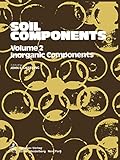Soil components [Libro electrónico] / editor: John E. Gieseking
Gieseking, John E [editor].
Tipo de material: Libro
en línea Series Editor: New York, New York, United States: Springer-Verlag, c1975Descripción: xi, 684 páginas : ilustraciones ; 27 centímetros.ISBN: 9783642659195 (Print); 9783642659171 (Online).Nota de acceso: Disponible para usuarios de ECOSUR con su clave de acceso Nota de bibliografía: Incluye bibliografía e índice: páginas 673-684 Número de sistema: 56033Contenidos:Mostrar
Resumen:
Libro
en línea Series Editor: New York, New York, United States: Springer-Verlag, c1975Descripción: xi, 684 páginas : ilustraciones ; 27 centímetros.ISBN: 9783642659195 (Print); 9783642659171 (Online).Nota de acceso: Disponible para usuarios de ECOSUR con su clave de acceso Nota de bibliografía: Incluye bibliografía e índice: páginas 673-684 Número de sistema: 56033Contenidos:Mostrar
Resumen:| Tipo de ítem | Biblioteca actual | Colección | Signatura | Estado | Fecha de vencimiento | Código de barras |
|---|---|---|---|---|---|---|
| Libros | Biblioteca Electrónica Recursos en línea (RE) | Acervo General | Recurso digital | ECO400560337874 |
Incluye bibliografía e índice: páginas 673-684
1. The classification of soil silicates and oxides.. 2. Micas in macroscopic forms.. 3. Fine-grained micas in soils.. 4. Smectites.. 5. The crystallography of minerals of the kaolin group.. 6. Vermiculites.. 7. Chlorites.. 8. Interstratified clay minerals.. 9. Fibrous minerals.. 10. Allophane.. 11. Oxides and hydrous oxides of silicon.. 12. Feldspar minerals.. 13. Heavy minerals.. 14. Bioliths.. 15. Water in soils.. 16. The thermal characteristics of soil minerals and the use of these characteristics in the qualitative and quantitative determination of clay minerals in soils.. 17. The characterization of soil minerals by infrared spectroscopy.. Index
Disponible para usuarios de ECOSUR con su clave de acceso
The major components of most soils are inorganic. These constituents are derived from the weathering of rocks and minerals or from subsequent reaetions and interactions of the weathering products. During the weathering and interactions of weathering products, in organic soil colloids are formed. Large amounts of inorganic colloids are essential in soils if they are to support luxurious plant growth. The colloids adsorb water and nutrient element s that might be lost from the soil &ystem and they release these as plants need them. They also adsorb and buffer the soil system against large excesses of soluble toxic substances that might otherwise exist as free moieties in soils. Soil and plant root interactions occur across two interfaces. One is the interface between plant roots and the liquid phase and the other is the interface between the soil particles and the liquid phase. Reaetions across the interface between colloid crystals and the soilliquid phase may also suppress the availability of nutrient elements to plants. The effectiveness of these interfaciaI reaetions in supporting optimum plant growth ultimately depends on the arrangements of ions in the surfaces and subsurfaces of the mineraI crystals. For this reason much of this volume is devoted to the arrangement of ions in crystalline mineraI particles commonly occuring in soils and the properties that these particles contribute to soiI systems. eng
Disponible en línea
Disponible en formato PDF
Subscripción a ELSEVIER 26 de diciembre del 2013
